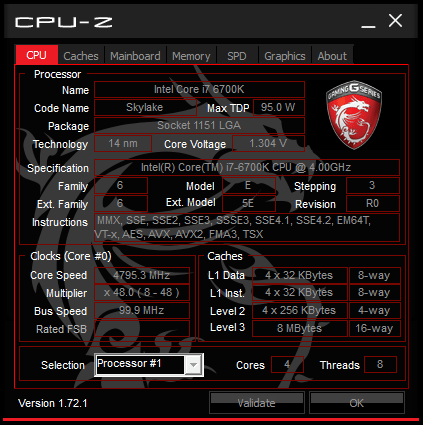Intel Core i7-6700K & i5-6600K “Skylake” Processors Review
Rikki Wright / 9 years ago
Overclocking
Intel’s Skylake Core i7-6700K CPU hopes to be a great overclocker when compared to its predecessors thanks to the 14nm process, high transistor count and just a general optimised process such as using higher quality thermal paste inside the CPU to remove as much heat as possible. It is recommended with the Skylake processors to not exceed 1.45v, so 1.4v on a daily overclocked machine should* be safe. Through rumours surrounding this CPU, an overclock of 5GHz is achievable on a basic AIO water cooling solution.
For our testing today, we will be using the MSI Z170A Gaming M7 motherboard. Aimed at the gamers and overclockers, this motherboard has more than enough features to adequately overclock and sustain that overclock than many other boards on the market. Thanks to a great BIOS design, the overclocking process is essentially the same as previous systems where you alter the multiplier, set XMP and adjust the voltage to your maximum limit. We are going to overclock at 1.5v due to this system being a testing system and not a daily machine.
*Overclocking is risky and should be taken a step at a time, not just jump straight in at the maximum settings
The first step is to go into the BIOS and find the Overclocking settings page; easy enough with the MSI BIOS.

This will show you the key settings that you can change, simply adjust the multiplier, enable XMP and set the voltage; then see if the system will boot. In our case, the system would boot at 5.1GHz at 1.48v, but was unstable in the vast majority of tests. I then tried 5GHz at 1.5v, but the system would not remain stable until the overclock settled at 4.8GHz. I then dialled down the voltage to 1.35v, the system actually ran lower than this, fluctuating around 1.29v, but during the loading process of certain applications, the voltage spiked to 1.343v.
The i5-6600K on the other hand, was more forgiving to an overclock and managed 4.9GHz at 1.5v. The system was unstable at higher clock speeds or lower voltage; so this was the optimal testing setting.
During this process, I also overclocked the IGP to use during the graphics tests; this was overclocked to 1.25GHz.

The final overclock was a great setting, but it only provided an additional 600MHz over the boost speed. Gone are the days of achieving over 1GHz like with the i7-2600K; although the i5 managed a huge 1GHz over the boost speed.




















